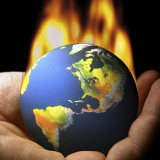By superimposing a big red “N” over the black “m” in “Global Warming”, the editors of a feature article on greenhouse gas emissions in NewScientist magazine (Nov. 17/12) altered the title to “Global WarNing”. This simple change of a single letter summarizes the sobering prospects of climate change induced by continuing to burn the fossil fuels that emit massive quantities of carbon dioxide into the atmosphere.
It’s a disconcerting subject that is uncomfortable to consider. But, as the scientific calculations and modelling become more refined and credible, the predictions become more ominous. So we are being forced to contemplate the consequences for our unfolding future.
The magazine’s article, of course, is couched in the rational and calm language of science. The graphs, too, seem decorative and innocuous — until their meaning actually begins to register. On virtually every front of the climate change issue, we are exceeding the worse case scenarios described in 2007 by the UN’s Intergovernmental Panel on Climate Change (IPCC). That prediction was for a 4°C global temperature increase by 2100. The revised prediction in 2009 was for 5°C. The 2011 revision was for 5.5°C. The most recent predictions are now 4°C by 2060 or 2070, with 6°C likely by 2100 and a 10 percent chance of 7°C. Meanwhile, the graph showing the actual annual tonnage of carbon dioxide emissions — 34.8 billion in 2011 — continues to angle steeply upward, the only sign of any reduction being a small dip during the “Great Recession” of 2008-9.
This is sobering information. Indeed, it’s scary for anyone who thinks beyond the moment and begins to imagine what these temperatures mean. The NewScientist article offers seven sketches.
- The volume of Arctic ice is “just a fifth of what it was three decades ago.” If current trends continue, the summer Arctic will be ice-free within a few decades. This means “more extreme weather in the northern hemisphere, faster melting of the Greenland ice sheet and greater releases of carbon currently locked away in permafrost.” Climate history has shown that even minor changes can have huge consequences — and the loss of Arctic ice is a major change.
- Global weather is getting more extreme. The water cycle has increased by double the rate anticipated in 2007 climate models. This means more heavy rainfall. The intensity of precipitation in China and Taiwan has increased ten-fold in the last three decades. Polar jet streams, the winds that distribute weather systems, slow down as the temperature difference decreases between the tropics and a faster-warming Arctic. Consequently, weather patterns tend to “get stuck”, causing longer hot spells, cold spells, droughts and rain storms.
- Slightly higher temperatures and a little more atmospheric carbon dioxide were expected to increase plant growth and, therefore, food production. But the anticipated benefits have been undone by the negative effects of extreme and irregular weather. The production of wheat, maize, rice and soybeans — 75 percent of humanity’s calories — fell by 1 percent between 1980 and 2008, and the decrease would have been 3 percent without more intensive fertilizing. In the US, scientists are predicting that production of these crucial calorie crops will fall by three-quarters by the end of this century if farmers attempt to grow them in existing locations. Above 35°C, many of such crops will fail to pollinate. The same scenario will apply elsewhere on the planet.
- Sea level rise is accelerating. The 0.3 mm per year predicted by the IPCC in 2007 is now 1.3 mm per year. Conservative predictions are for a total rise of one meter by 2100, with a possibility of 2 metres. This would cause havoc in most major coastal cities.
- Warming oceans and land will absorb less carbon dioxide, thereby increasing the atmospheric effect of continuing emissions. Rising temperatures will also release methane, methane hydrates and carbon dioxide presently held in cold storage, thereby accelerating the warming process.
- Present carbon dioxide emissions have now reached the top of the 2007 IPCC’s worst case scenario. Even if we were willing and capable of cutting emissions dramatically and immediately, we are “most probably” on the path to a 4°C rise by 2100, “way above the 2°C level it was declared we should avoid at all costs” (Ibid.). Most scientists, the NewScientist notes, “have underplayed the significance of the emissions story to make their message politically more acceptable” (Ibid.).
- Heat stress becomes an issue in hotter conditions. People are unable to perspire sufficiently to cool themselves when humidity and temperature rise beyond the so-called “wet-bulb temperature” of 35°C — they suffer exhaustion, heat stroke and kidney failure. A planet that warms by 7°C would render “vast swaths of Africa, Australia, China, Brazil, India and the US…uninhabitable for at least part of the year” (Ibid.).The full “development” of all the world’s fossil fuels would eventually create a largely “unliveable planet”.
This is the preliminary scenario presented by the thousands of scientists who are working toward the next official IPCC report due in 2014. It’s a conscientious and dispassionate effort to describe the future we are creating — a future that no one will like.

